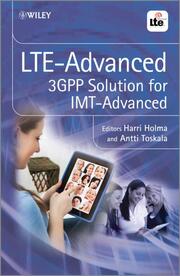-
Zusatztext
-
Examining the main technical enhancements brought by LTE-Advanced (LTE-A), this book thoroughly covers 3GPP R10 and R11 specifications. Using illustrations, graphs and real-life scenarios, the authors systematically lead readers through this cutting-edge topic to provide an outlook on existing technologies as well as possible future developments. The book is structured to follow the main technical areas that will be enhanced by the new LTE-A specifications. Topics covered include: 3GPP milestones and outlook to Release 11; LTE-Advanced in IMT-Advanced process in ITU-R; Downlink Carrier Aggregation; Coordinated Multipoint Transmission (CoMP); Heterogeneous Networks; and HSPA Evolution. It concludes with an outlook towards Release 11 and 12, introducing 3GPP Release 11 study and work items.
-
-
Autorenportrait
- InhaltsangabeList of Contributors xiii Preface xv Acknowledgements xvii List of Abbreviations xix 1 Introduction 1 Harri Holma and Antti Toskala 1.1 Introduction 1 1.2 Radio Technology Convergence Towards LTE 1 1.3 LTE Capabilities 3 1.4 Underlying Technology Evolution 4 1.5 Traffic Growth 4 1.6 LTEAdvanced Schedule 6 1.7 LTEAdvanced Overview 6 1.8 Summary 7 2 LTEAdvanced Standardization 8 Antti Toskala 2.1 Introduction 8 2.2 LTEAdvanced and IMTAdvanced 8 2.3 LTEAdvanced Requirements 9 2.4 LTEAdvanced Study and Specification Phases 10 2.5 Further LTE-Advanced 3GPP Releases 11 2.6 LTEAdvanced Specifications 11 2.7 Conclusions 12 References 12 3 LTE Release 8 and 9 Overview 14 Antti Toskala 3.1 Introduction 14 3.2 Physical Layer 14 3.3 Architecture 22 3.4 Protocols 23 3.5 EPC and IMS 26 3.6 UE Capability and Differences in Release 8 and 9 27 3.7 Conclusions 28 References 29 4 Downlink Carrier Aggregation 30 Mieszko Chmiel and Antti Toskala 4.1 Introduction 30 4.2 Carrier Aggregation Principle 30 4.3 Protocol Impact from Carrier Aggregation 33 4.4 Physical Layer Impact from Carrier Aggregation 38 4.5 Performance 42 4.6 Band Combinations for Carrier Aggregation 46 4.7 Conclusions 48 Reference 49 5 Uplink Carrier Aggregation 50 Jari Lindholm, Claudio Rosa, Hua Wang and Antti Toskala 5.1 Introduction 50 5.2 Uplink Carrier Aggregation Principle 50 5.3 Protocol Impacts from Uplink Carrier Aggregation 51 5.4 Physical Layer Impact from Uplink Carrier Aggregation 52 5.5 Performance 56 5.6 Band Combinations for Carrier Aggregation 61 5.7 Conclusions 62 References 62 6 Downlink MIMO 63 Timo Lunttila, Peter Skov and Antti Toskala 6.1 Introduction 63 6.2 Downlink MIMO Enhancements Overview 63 6.3 Protocol Impact from Downlink MIMO Enhancements 64 6.4 Physical Layer Impact from Downlink MIMO 65 6.5 Performance 70 6.6 Conclusions 73 References 74 7 Uplink MIMO 75 Timo Lunttila, Kari Hooli, YuYu Yan and Antti Toskala 7.1 Introduction 75 7.2 Uplink MIMO Enhancements Overview 75 7.3 Protocol Impacts from Uplink MIMO 76 7.4 Physical Layer Impacts from Uplink MIMO 77 7.4.1 Uplink Reference Signal Structure 77 7.4.2 MIMO Transmission for Uplink Data 79 7.4.3 MIMO Transmission for Uplink Control Signalling 82 7.4.4 MultiUser MIMO Transmission in the Uplink 82 7.5 Performance 83 7.6 Conclusions 84 References 85 8 Heterogeneous Networks 86 Harri Holma, Patrick Marsch and Klaus Pedersen 8.1 Introduction 86 8.2 Base Station Classes 87 8.3 Traffic Steering and Mobility Management 89 8.3.1 Traffic Steering and Mobility Management in Idle State 90 8.3.2 Traffic Steering and Mobility Management in the Connected State 91 8.3.3 Traffic Steering and Mobility Management with Femto Cells 91 8.3.4 WiFi Offloading 92 8.4 Interference Management 94 8.4.1 Static Interference Avoidance through Frequency Reuse Patterns 96 8.4.2 Dynamic Interference Coordination in the Frequency Domain 97 8.4.3 Dynamic Interference Coordination in the Time Domain 98 8.4.4 Dynamic Interference Coordination in the Power Domain 101 8.5 Performance Results 101 8.5.1 Macro and Outdoor Pico Scenarios 102 8.5.2 Macro and Femto Scenarios 105 8.6 Local IP Access (LIPA) 107 8.7 Summary 108 References 108 9 Relays 110 Harri Holma, Bernhard Raaf and Simone Redana 9.1 Introduction 110 9.2 General Overview 111 9.3 Physical Layer 112 9.3.1 Inband and Outband Relays 112 9.3.2 Subframes 113 9.3.3 Retransmissions 115 9.3.4 Relays Compared to Repeaters 116 9.3.5 Relays in TD-LTE 118 9.4 Architecture and Protocols 118 9.4.1 Subframe Configuration with Relay Nodes 118 9.4.2 Bearer Usage with Relay Nodes 119 9.4.3 Packet Header Structure in the Relay Interface 120 9.4.4 Attach Procedure 121 9.4.5 Hand
Detailansicht
LTE Advanced
3GPP Solution for IMT-Advanced
ISBN/EAN: 9781119974055
Umbreit-Nr.: 1503081
Sprache:
Englisch
Umfang: 248 S.
Format in cm:
Einband:
gebundenes Buch
Erschienen am 17.08.2012
Auflage: 1/2012


